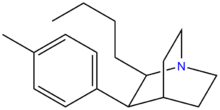Butyltolylquinuclidine
From Wikipedia, the free encyclopedia
This is an old revision of this page, as edited by Anypodetos (talk | contribs) at 20:15, 25 December 2013 (Drugbox additions). The present address (URL) is a permanent link to this revision, which may differ significantly from the current revision.
 | |
| Clinical data | |
|---|---|
| ATC code |
|
| Legal status | |
| Legal status |
|
| Identifiers | |
| |
| PubChem CID | |
| ChemSpider | |
| Chemical and physical data | |
| Formula | C18H27N |
| Molar mass | 257.414 g/mol g·mol−1 |
| 3D model (JSmol) | |
| |
| |
| (verify) | |
2-Butyl-3-(p-tolyl)quinuclidine (BTQ) is a stimulant DRI.[1] It is one of a number of substituted quinuclidine derivatives developed as potential medications for the treatment of cocaine abuse,[2] and produces similar effects to cocaine in animal studies, although milder and longer lasting.
References
- ^ Attention: This template ({{cite pmid}}) is deprecated. To cite the publication identified by PMID 12614900, please use {{cite journal}} with
|pmid=12614900instead. - ^ Attention: This template ({{cite pmid}}) is deprecated. To cite the publication identified by PMID 12565962, please use {{cite journal}} with
|pmid=12565962instead.
This drug article relating to the nervous system is a stub. You can help Wikipedia by expanding it. |
Hidden categories:
- Drugs with non-standard legal status
- Chem-molar-mass both hardcoded and calculated
- Infobox-drug molecular-weight unexpected-character
- Chemical articles without CAS registry number
- Articles without EBI source
- Chemical pages without DrugBank identifier
- Articles without KEGG source
- Articles without UNII source
- All stub articles
